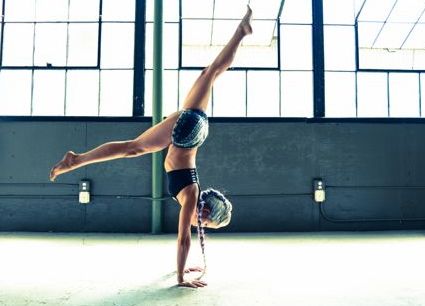Inversions conjure up a lot of fear, and rightfully so since there’s always a chance of falling. However, going upside down can be wildly liberating in many ways. Practicing inversions such as forearm stand, handstand and headstand has a wide range of benefits such as aiding the lymphatic system, letting go of fear and trusting yourself. Below are three main components needed for mastering inversions.
Yoga Breathing
Before coming into an inversion, start in a child’s pose so you can create a smooth and calm breath. Yoga breathing, or ujayii breath, is the number one most important thing. Try to create at least five rounds of long, slow breaths before setting up for the posture. When we stop breathing, we tense up, the mind wanders and we are easily swayed into fear thoughts. If you can maintain a calm breath, it is more likely that the mind will also remain present and relaxed. The breath is the support and power behind our practice so do the best you can to stay connected to it the entire time.
Maintain Concentration
In yoga, concentration is called Dharana and it is the prerequisite for meditation. We must learn to focus in order to control the breath and the mind. There are several techniqus available for increasing concentration.
- Drishti – Using a focal point while practicing yoga or meditating is called a drishti. It is something physical that you can place your gaze on for an extended period of time but it can also be an internal focal point, like the third eye or a certain body part. By keeping the eyes steady on one spot, the mind stays present. Someone once said, “if the eyes wander, the mind wanders.” Keep the gaze focused on one spot so the mind can stay focused on breathing. This helps to keep the mind away from thoughts filled with fear or self-doubt. Drishti is a powerful tool that increases stability while balancing in an inversion, and it also turns your entire class into a moving meditation.
- Mantras are repeated to ourselves so the mind doesn’t wander. One of the main reasons for falling out of inversions comes from a break in concentration. If you are able to hold the pose for a few seconds, the mind automatically thinks, “hooray, I am doing the pose!” and at that very second, we collapse. Why? The mind was no longer in the pose. It was rejoicing at having done it. The same hold true when we can’t hold the pose at all. The mind wanders to reasoning, judging and comparing. Repeating a mantra such as “I am aware that I am inhaling” as we take a deep breath in and “I am aware that I’m exhaling” as we take a full breath out will keep us present.
- Pratyahara is the fourth limb of yoga and it refers to withdrawing the senses. Imagine a turtle drawing its limbs and head into the shell – that is pratyahara. Taking the awareness inward so we are not easily distracted by the senses and external objects. When we can engage pratyahara, concentration is possible. Without concentration it would be impossible to do inversions.
Improve Abdominal Strength
Where exactly are the abominal muscles? When we think of our abs, the front of our body betwen the chest and the hips usually comes to mind. We might even think about washboard abs, or the almighty six pack. However, that is but one level of the abdominal muscle anatomy. Think of your core as a four-quadrant cylinder that wraps around from your diaphram to both sides of the ribcage and from the pelvis to both sides of the lower back. Your abs are basically the entire lower trunk of your body starting from beneath your chest all the way down to the hip and leg attachment. In order to do a lot of the arm balances, inversions and floating techniques required as we progress through our practice, we have to target the abdominals from every angle. Try these core exercises at least once a day; when you start feeling stronger, try the core exercises on our youTube channel. You can start with sets of eight and slowly increase up to twenty-five reps. The idea is to work the muscles to exhaustion so you can start increasing your endurance!


Leave a Reply
You must be logged in to post a comment.